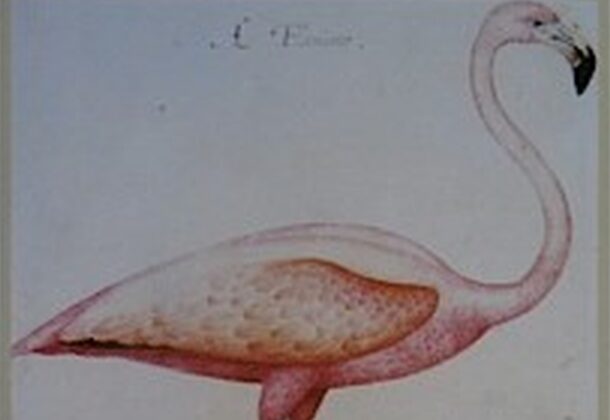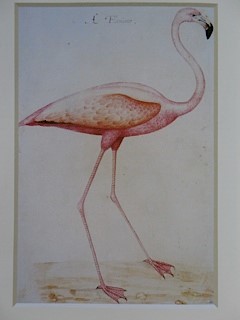Roanoke Gov. Paints 1st Flamingo

From the beginning of our time, our ancestors have been fascinated by the incredibly beautiful orange and red flamingos that grace our world. From the Rift Valley in Africa, to the high Andes Mountains in South America, to the translucent shores of the Caribbean and Mediterranean Seas, early civilizations were captivated by large flocks of these incredibly colorful birds.
There are four species of flamingos in the Americas and two in Europe and Asia. The most colorful species is the Caribbean Flamingo; the most numerous is the Lessor Flamingo in Tanzania; the Greater Flamingo is the most geographically dispersed as it is found in Africa, Europe, and Asia.
The bill of the flamingo is one of the more unusual bills in the bird world as it is used upside down! When they feed, the bird dips its bill underwater and scoops its upside down head backward and forward to filter small crustaceans and plant life. Their red color is caused by the beta carotene found in shrimp and algae in their diet.
The first known painting of a flamingo in America is a watercolor by John White (1577-1593), who was the governor of the famous Lost Colony of Roanoke Island, Virginia, founded by his friend Sir Walter Raleigh in 1585. White made an impressive five voyages to America and on his second trip in 1587, he took his daughter, son-in-law, and 150 colonists to settle on Roanoke Island.
His daughter gave birth to the first English child born in America, Virginia Dare. Within a year, however, some of the colonists were terribly dissatisfied with the new colony and insisted that White take them back to England. He reluctantly agreed but promised his daughter and the other colonists that he would return quickly with additional colonists and more supplies.
His intentions were thwarted by the threat of a Spanish invasion of England which prevented him from returning to Virginia for three years. When he finally returned in 1590, the colonists were gone, never to be seen again. There was no signs of struggle or battle, they had simply vanished. The only clue was a single word carved on a tree, “Croatan.” The mystery has never been solved but the Lost Colony DNA Project was established in 2007 to find the English relatives of the colonists and the descendants of the Croatan Indians to determine if the lost colonists were assimilated into the native tribes.
single word carved on a tree, “Croatan.” The mystery has never been solved but the Lost Colony DNA Project was established in 2007 to find the English relatives of the colonists and the descendants of the Croatan Indians to determine if the lost colonists were assimilated into the native tribes.
White was not only a traveler and adventurer; he also was an incredibly good watercolorist. He painted over 60 American birds including this lovely watercolor of a flamingo. This painting is a masterpiece of delicate and intricate shading of white, black, and pink feathers. It is elegant in its simplicity. Since flamingos are not found as far north as Virginia, White probably saw this bird in Florida or the Bahama Islands.
It was Alexander Wilson who published the first book in America of our birds with beautiful hand-colored lithographs.
Dennis B. Williams Rare and Antique Bird Prints is liquidating the last of its collection. Information on available prints is available on their Member Page. Or email [email protected].
Read about another of Wilson’s flamingo prints in “Wilson Beat Audubon to the Birds.”




















